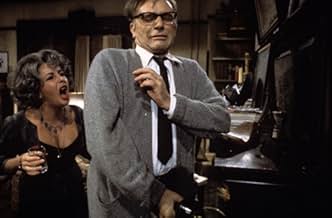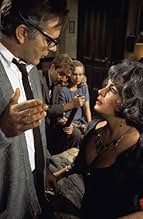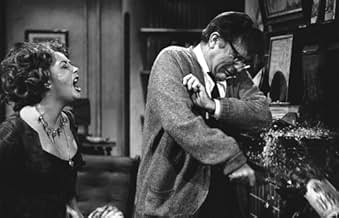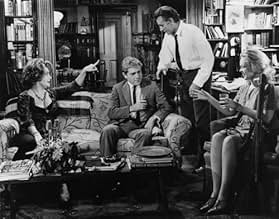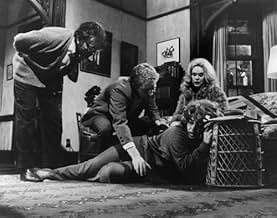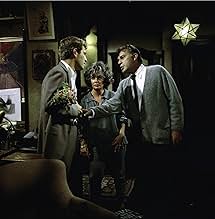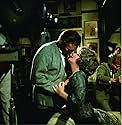Una pareja amarga y envejecida, con la ayuda del alcohol, usa a una pareja joven para alimentar la angustia y el dolor emocional entre ellos.Una pareja amarga y envejecida, con la ayuda del alcohol, usa a una pareja joven para alimentar la angustia y el dolor emocional entre ellos.Una pareja amarga y envejecida, con la ayuda del alcohol, usa a una pareja joven para alimentar la angustia y el dolor emocional entre ellos.
- Dirección
- Guionistas
- Elenco
- Ganó 5 premios Óscar
- 22 premios ganados y 26 nominaciones en total
- Dirección
- Guionistas
- Todo el elenco y el equipo
- Producción, taquilla y más en IMDbPro
Opiniones destacadas
10Rathko
An undisputed classic that chronicles every appalling moment of a drunken night in hell as middle-aged George and Martha tear each other, and their guest, to pieces.
Elizabeth Taylor proves categorically that she was a truly great actress. Her Oscar-winning performance as the psychologically tormented Martha is one of the greatest performances in the history of cinema. Taylor's imperceptible shifting from sadism to tenderness, from bullying condescension to exhausted vulnerability, is a masterclass in character building. Martha is a truly monstrous character, and yet Taylor is able to imbue her with sympathy, allowing you brief glimpses of the warm and lovable woman she could have been.
Richard Burton is equally magnificent as George; an ageing, failing college professor whose initial meekness gives way to a raging torment all of his own. His verbal sparring with Taylor, like two pit-bulls in the ring of an endless and bloody dogfight, has become legendary. Every word drips with malice and contempt, every sentence is designed to cut the deepest wound. At times, it becomes painful to watch, but like true train-wreck television, you cannot drag yourself away from the inevitably terrible conclusion.
Quite possibly, this is as close to perfect as movies can get; beautifully written dialogue, deeply complex characters, an evolving and suspenseful storyline, beautiful photography, and a wonderfully understated score by Alex North. Nominated for 13 Academy Awards in 1967, but lost out to A Man for All Seasons and Born Free to win only 5.
"Who's Afraid of Virginia Woolf?" "I am."
Elizabeth Taylor proves categorically that she was a truly great actress. Her Oscar-winning performance as the psychologically tormented Martha is one of the greatest performances in the history of cinema. Taylor's imperceptible shifting from sadism to tenderness, from bullying condescension to exhausted vulnerability, is a masterclass in character building. Martha is a truly monstrous character, and yet Taylor is able to imbue her with sympathy, allowing you brief glimpses of the warm and lovable woman she could have been.
Richard Burton is equally magnificent as George; an ageing, failing college professor whose initial meekness gives way to a raging torment all of his own. His verbal sparring with Taylor, like two pit-bulls in the ring of an endless and bloody dogfight, has become legendary. Every word drips with malice and contempt, every sentence is designed to cut the deepest wound. At times, it becomes painful to watch, but like true train-wreck television, you cannot drag yourself away from the inevitably terrible conclusion.
Quite possibly, this is as close to perfect as movies can get; beautifully written dialogue, deeply complex characters, an evolving and suspenseful storyline, beautiful photography, and a wonderfully understated score by Alex North. Nominated for 13 Academy Awards in 1967, but lost out to A Man for All Seasons and Born Free to win only 5.
"Who's Afraid of Virginia Woolf?" "I am."
Simply put, this is one of my favourite films of all time. Great acting, great writing and great camerawork make this close to cinematic perfection. Liz Taylor and Richard Burton give the performances of their lives. Sandy Dennis also shines in an early-ish role. It's a dramatic film, but the wicked humour that permeates the film is absolutely devastating, and I mean that in the best possible way. Many moments in the film I find myself laughing only to think, "Should I be laughing at this." Certainly the film is loaded with uncomfortable moments, enhanced by the camerawork replete with uneasy close-ups. Most of all, this film shows how a lot can be accomplished with just a little: a cast of four and minimal scenery changes. "Who's Afraid Of Virginia Woolf" has become an absolute icon of American cinema. If you haven't seen it, what are you waiting for?
10RWiggum
'Who's Afraid of Virginia Woolf' tells the story of two couples that are quite different at first sight - one used to each other for years, the other one rather freshly wed in comparison. Actually it doesn't tell their story, but it displays their relationships.
The film begins on a Sunday morning at 2 o'clock, right after a party, and ends just after the sun rises. In these few hours we get to know these four people better then we might possibly want.
George and Martha are the older couple. He is a history professor, she is the daughter of the head of the university. Their relationship seems to be from hell, full of mutual disgust and humiliation. Their guests are Nick and Honey. He is the new, ambitious biology professor, she is his naive young wive. As all these four characters are more or less drunk throughout the entire film, alcohol works as a catalyst, and we quickly see the different kind of character traits they have: George is a cynic, Martha loves to torment her husband, Nick is an opportunist and Honey is very much a stupid blonde.
The two relationships deserve closer examination: We wonder why Martha and George married in the first place. They keep swearing at each other. Martha can't stop humiliating George, when they are alone as well as when Nick and Honey are there. Maybe there is still a rest of love in them, but there mutual respect has vanished completely. And then there is the strange story of their son, who is supposed to visit on his birthday. They way George and Martha talk about him make us feel that there is something peculiar about him. At the end we get to know more about him, and we can only guess how important the son is for their relationship.
Nick and Honey, on the other hand, seem to be quite the opposite. But, being used as weapons by the older couple, we see that their relationship isn't as perfect as it seems to be, either. Nick didn't marry Honey because he loved her, but because he thought she was pregnant and because of her money. And when Martha tries to seduce him to tease George, he plays the game with her, always in mind that this woman's father is the head of the university. Honey, on the other hand, is much more emotional than her husband, but she also is the most passive character, and the one most affected by the alcohol.
Mike Nichols assembled an outstanding cast for his film. Casting Elizabeth Taylor and Richard Burton as Martha and George is a stroke of genius - not only are they terrific actors, but it also heats the imagination of the viewer how much their real-life-marriage resembled the relationship they had in this film. Elizabeth Taylor outshines her co-stars a little. Never was she any better than in this one; although her character is the meanest in the film, she manages that we still feel compassion for her at the end. But Richard Burton, George Segal and especially Sandy Dennis deliver memorable performances, too.
'Who's Afraid of Virginia Woolf' succeeds at something rather difficult: It makes us care for characters we wouldn't want to have anything to do with in real life. And although it actually consist of nothing but four people talking for two hours, it never bored us for a second.
The film begins on a Sunday morning at 2 o'clock, right after a party, and ends just after the sun rises. In these few hours we get to know these four people better then we might possibly want.
George and Martha are the older couple. He is a history professor, she is the daughter of the head of the university. Their relationship seems to be from hell, full of mutual disgust and humiliation. Their guests are Nick and Honey. He is the new, ambitious biology professor, she is his naive young wive. As all these four characters are more or less drunk throughout the entire film, alcohol works as a catalyst, and we quickly see the different kind of character traits they have: George is a cynic, Martha loves to torment her husband, Nick is an opportunist and Honey is very much a stupid blonde.
The two relationships deserve closer examination: We wonder why Martha and George married in the first place. They keep swearing at each other. Martha can't stop humiliating George, when they are alone as well as when Nick and Honey are there. Maybe there is still a rest of love in them, but there mutual respect has vanished completely. And then there is the strange story of their son, who is supposed to visit on his birthday. They way George and Martha talk about him make us feel that there is something peculiar about him. At the end we get to know more about him, and we can only guess how important the son is for their relationship.
Nick and Honey, on the other hand, seem to be quite the opposite. But, being used as weapons by the older couple, we see that their relationship isn't as perfect as it seems to be, either. Nick didn't marry Honey because he loved her, but because he thought she was pregnant and because of her money. And when Martha tries to seduce him to tease George, he plays the game with her, always in mind that this woman's father is the head of the university. Honey, on the other hand, is much more emotional than her husband, but she also is the most passive character, and the one most affected by the alcohol.
Mike Nichols assembled an outstanding cast for his film. Casting Elizabeth Taylor and Richard Burton as Martha and George is a stroke of genius - not only are they terrific actors, but it also heats the imagination of the viewer how much their real-life-marriage resembled the relationship they had in this film. Elizabeth Taylor outshines her co-stars a little. Never was she any better than in this one; although her character is the meanest in the film, she manages that we still feel compassion for her at the end. But Richard Burton, George Segal and especially Sandy Dennis deliver memorable performances, too.
'Who's Afraid of Virginia Woolf' succeeds at something rather difficult: It makes us care for characters we wouldn't want to have anything to do with in real life. And although it actually consist of nothing but four people talking for two hours, it never bored us for a second.
10OttoVonB
Ailing couple George (Burton) and Martha (Taylor) invite a young couple over for a late-night drink - much to quiet and repressed George's annoyance - and what starts off as a twisted game by sultry Martha to annoy her husband and get her way with young stud Nick (George Segal) ends up in a horrific duel of wits.
Adapted from the play and boasting very few locations, "Virginia Woolf" is notable for many unsuspected reasons. Designed for the stage, the film makes the story uniquely cinematic and tense, amped up by stunning photography (in Black and White, a daring choice in 1966). The younger leads are superb, but Burton and Taylor still manage to walk away with film, giving stunning renditions of the world's most demented couple. They make the surreal dialogue hurt and touch in ways never thought possible.
Though there are countless reasons to recommend this jewel of a film, there are also reasons why one would wish to avoid it. This is the kind of film that makes you feel like having a showing (or a very concentrated drink) to wash away the grit and human evil and pain absorbed. You'll feel dirty, but in a way you'll also feel enlightened: that a small character film can carry more punch than any explosion-packed blockbuster out there is a thing of beauty indeed!
Adapted from the play and boasting very few locations, "Virginia Woolf" is notable for many unsuspected reasons. Designed for the stage, the film makes the story uniquely cinematic and tense, amped up by stunning photography (in Black and White, a daring choice in 1966). The younger leads are superb, but Burton and Taylor still manage to walk away with film, giving stunning renditions of the world's most demented couple. They make the surreal dialogue hurt and touch in ways never thought possible.
Though there are countless reasons to recommend this jewel of a film, there are also reasons why one would wish to avoid it. This is the kind of film that makes you feel like having a showing (or a very concentrated drink) to wash away the grit and human evil and pain absorbed. You'll feel dirty, but in a way you'll also feel enlightened: that a small character film can carry more punch than any explosion-packed blockbuster out there is a thing of beauty indeed!
One only has sympathy for these ultimately dysfunctional characters as they unfold their little "fun and games," like "Down the Host," "Hump the Hostess," and "Get the Guests." If only George and Martha had retired a wee bit earlier none of this would've happened.
Then, too, why didn't Nick and Honey simply leave, rather than stick around for the "full treatment"? Can it be that "like attracts like," so much so that they couldn't leave?
The final denouement suggests that a new day may be in the offing for poor Martha and George, after the latter has "killed off the 'little bugger.' " Although Martha's admittedly still fearful, she clings firmly to George's hand. Perhaps there's some hope, anyway, for this emotionally spent couple.
Edward Albee, taking no small degree of awareness from Tennessee Williams and Harold Pinter, crafted a play that certainly communicated to a goodly number of people.
Personally recalling sitting in its Broadway run, watching Uta Hagen and cast go through their paces, I remember being as impressed with the riotous audience laughter as with the play itself. The raw lines coming from up-to-then very respectable status characters, namely college prof and wife, seemed to provide some kind of early 60s liberation from the staid and repressive 50s.
By the time the film was released in '66, the public was ready for its no-holds-barred dialogue. It ushered in an new era of social upheaval, of which we're still feeling the effects today.
The "boozy battle" between the hosts, hosts and guests, and guests and guests, paralleled the cultural "steam" being released during that politically "hot" period. The American home drastically changed as a nation experienced more domestic squabbles, separations, divorces, custody battles, and family breakdowns--the last including a noted demise of the traditional "family meal."
In Albee's "long night's journey into morning," the audience must endure two hours of fighting, bickering, insulting, and lamenting before any ray of hope is introduced (during its last five minutes). A long time to wait, but there it is: a glimmer that there may be something better ahead. But we're not sure; after all, "Is this fact or fiction, Martha?"
In an extensive GM Quarterly interview, Director Mike Nichols revealed that this was a very troubled production that almost didn't get finished--with a leading cast boozing and pill-dosing even during lunch breaks--stretching the very limits of professionalism.
Yet in the end, Nichols, Cinematographer Haskell Wexler, and Composer Alex North all got what they wanted. A question is, "was it all worth the effort?" That's something only the individual viewer can answer: is this a case of "nothing from nothing leaves nothing?" or "a cathartic and emotionally moving experience?"
Then, too, why didn't Nick and Honey simply leave, rather than stick around for the "full treatment"? Can it be that "like attracts like," so much so that they couldn't leave?
The final denouement suggests that a new day may be in the offing for poor Martha and George, after the latter has "killed off the 'little bugger.' " Although Martha's admittedly still fearful, she clings firmly to George's hand. Perhaps there's some hope, anyway, for this emotionally spent couple.
Edward Albee, taking no small degree of awareness from Tennessee Williams and Harold Pinter, crafted a play that certainly communicated to a goodly number of people.
Personally recalling sitting in its Broadway run, watching Uta Hagen and cast go through their paces, I remember being as impressed with the riotous audience laughter as with the play itself. The raw lines coming from up-to-then very respectable status characters, namely college prof and wife, seemed to provide some kind of early 60s liberation from the staid and repressive 50s.
By the time the film was released in '66, the public was ready for its no-holds-barred dialogue. It ushered in an new era of social upheaval, of which we're still feeling the effects today.
The "boozy battle" between the hosts, hosts and guests, and guests and guests, paralleled the cultural "steam" being released during that politically "hot" period. The American home drastically changed as a nation experienced more domestic squabbles, separations, divorces, custody battles, and family breakdowns--the last including a noted demise of the traditional "family meal."
In Albee's "long night's journey into morning," the audience must endure two hours of fighting, bickering, insulting, and lamenting before any ray of hope is introduced (during its last five minutes). A long time to wait, but there it is: a glimmer that there may be something better ahead. But we're not sure; after all, "Is this fact or fiction, Martha?"
In an extensive GM Quarterly interview, Director Mike Nichols revealed that this was a very troubled production that almost didn't get finished--with a leading cast boozing and pill-dosing even during lunch breaks--stretching the very limits of professionalism.
Yet in the end, Nichols, Cinematographer Haskell Wexler, and Composer Alex North all got what they wanted. A question is, "was it all worth the effort?" That's something only the individual viewer can answer: is this a case of "nothing from nothing leaves nothing?" or "a cathartic and emotionally moving experience?"
¿Sabías que…?
- TriviaThis became the first movie in Academy Awards history since Cimarron (1931) to be nominated for every Academy Award category in which it was eligible, including Best Adapted Screenplay (Ernest Lehman), Director (Mike Nichols), all of the acting categories (Richard Burton, Dame Elizabeth Taylor, George Segal and Sandy Dennis) and Picture of the Year (Ernest Lehman).
- ErroresThe four characters stop at a bar after the first soiree at George's house. It is clearly after 2:00 a.m., since the time was stated during the first segment. No bars, however, would have been open after 1 or 2 a.m. in the New England states, where the film is set.
- ConexionesEdited from La carta trágica (1940)
- Bandas sonorasWho's Afraid of Virginia Woolf?
(to the tune of "Here We Go Round the Mulberry Bush")
Traditional English melody
Original lyrics ("Who's Afraid of the Big Bad Wolf?") by Frank Churchill and Ann Ronell; modified by Edward Albee
Performed by Elizabeth Taylor
Selecciones populares
Inicia sesión para calificar y agrega a la lista de videos para obtener recomendaciones personalizadas
Detalles
- Fecha de lanzamiento
- País de origen
- Idiomas
- También se conoce como
- Who's Afraid of Virginia Woolf?
- Locaciones de filmación
- Cambridge, Massachusetts, Estados Unidos(location)
- Productoras
- Ver más créditos de la compañía en IMDbPro
Taquilla
- Presupuesto
- USD 7,500,000 (estimado)
- Total en EE. UU. y Canadá
- USD 28,000,000
- Total a nivel mundial
- USD 28,007,258
- Tiempo de ejecución2 horas 11 minutos
- Color
- Mezcla de sonido
- Relación de aspecto
- 1.85 : 1
Contribuir a esta página
Sugiere una edición o agrega el contenido que falta

Principales brechas de datos
By what name was ¿Quién le teme a Virginia Woolf? (1966) officially released in India in English?
Responda

